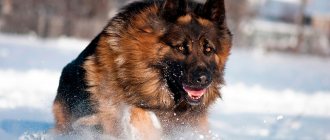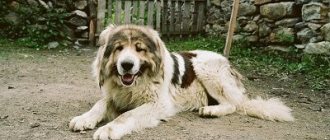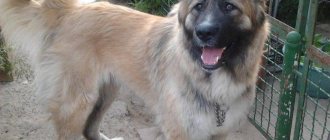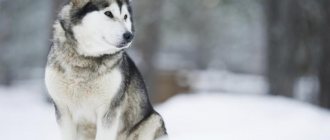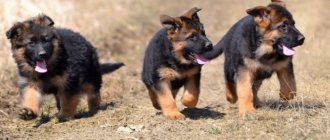Living in a private home
For a German Shepherd, the most optimal conditions are keeping it outdoors or in a private household . If you decide to keep your dog on the street, it is important to adhere to a number of rules:
- the dog’s home is installed in such a way that one part is located in the shade, and the sun’s rays fall on the other;
- the floor covering can be represented by hard soil or a well-compacted sand-crushed stone cushion;
- You can use wood shavings or straw as bedding;
- It is mandatory to install an effective drainage system that will keep the dog’s home dry;
- the booth is installed in the middle of an outdoor enclosure, the covering of which can be represented by ordinary wooden flooring.
This is interesting! It is advisable to make the roofing of the booth from metal tiles or slate, but the second option is more acceptable. It is important to remember that the dog’s kennel and enclosure require regular disinfection and constant care.
The dog should be regularly taken outside the fenced area of the yard or enclosure, which will allow it to be introduced to the outside world and respond adequately to strangers, other animals or sharp sounds. When keeping a four-legged pet in an enclosure, it is important to ensure decent physical development. For this purpose, the animal is given a daily one-hour walk, which includes active jogging and play elements.
Return to content
Why are walks necessary?
Being outside is good for your puppy, but that's not all. When kept in an apartment, frequent walks are an excellent way to teach your pet to relieve itself outside its own walls. And in the first three months, get ready to get up even at night to take your baby out. Puppies are easy to train, so with proper attention and care, your pet will soon start asking to go outside.
Until six months, the shepherd's back is not yet strong, so you will have to carry it in your arms so that it does not injure itself while jumping up the steps. On the street, during outdoor games, do not allow the puppy to overcome high barriers. Also beware of chasing cats.
It is best to walk your dog during the day, under the sun's rays. This promotes the body's production of natural vitamin D.
In the first weeks on the street, try to avoid other dogs, especially strays. Choose a small, clean area where the puppy can run freely without harming his health. Gradually, going to special areas for dogs, allow the grown-up pet to get acquainted with other puppies, without particularly infringing on his freedom. If an adult dog runs up to your baby, don’t be afraid, German Shepherd puppies are very brave and will be able to stand up for themselves.
Keeping a dog in an apartment
From the point of view of convenience, keeping a German Shepherd in an apartment environment has some difficulties, which is due to the large size of the animal. During a walk, people around them treat such dogs with some distrust and even fear, so to walk a German Shepherd you need to choose specially designated areas or dog areas.
The main rule for properly keeping a German Shepherd dog in an apartment environment is the obligatory allocation of a separate place for the animal in the room. In order to arrange such a place, it is necessary to purchase a bedding with a removable high-quality cover, which must be washed periodically. It is very important to socialize your pet from a very early age, and also teach him not to climb into electrical outlets, not to chew cables or laces, and not to climb on the bed or kitchen furniture.
As a rule, the German Shepherd quickly adapts to the peculiarities of apartment living, and therefore does not require the creation of any special conditions. However, in this case, greater attention should be paid to hygiene rules. German dogs have a very well-defined coat, so only following the entire range of hygiene measures will prevent the appearance of a very specific smell and clumps of flying hair in the house.
Return to content
About nutrition
Puppies grow quickly. A two-month-old baby is fed 5 times a day. Growing up, the puppy eats less often, and by 10–12 months he switches to 2 meals a day.
What to feed, natural products or dry food, is up to the owner to decide. Adherents of both types of food will have their own pros and cons. You will need to choose a single type in advance, before the baby arrives in the house. When organizing feeding your pet, it is important to consider the following points:
- For the first few days, you will have to feed the puppy according to the breeder’s requirements. Then gradually switch to the chosen type of food.
- The diet is balanced taking into account the age of the dog, and vitamin and mineral supplements are included if necessary.
- The shepherd should be fed food at room temperature at the same time.
- Overeating must not be allowed! If, after eating a portion, the dog licked the dishes and moved away, it means there was enough food; if it does not move away from the bowl, it is possible to add more.
- German Shepherds should be fed 40 minutes after walks (due to their structure, they remain prone to gastric volvulus).
- Fresh water is always available to the animal.
- Bowls with food and water are located at the level of the dog's chest so as not to harm the spine, neck and joints of the front legs. Special stands with adjustable height for mounting bowls are sold.
- The dog should be calm when the owner approaches the bowl, and begin eating with the owner’s permission (reason: the leader of the pack is the owner, not the animal).
- Tubular bones, sweets, salty and smoked food are not for dogs.
Optimal conditions of detention
The German Shepherd belongs to the category of breeds that are able to live completely comfortably in absolutely any conditions. However, the most optimal option for keeping a German Shepherd, according to many breeders and dog handlers, is private household ownership. The coat of such a dog can effectively protect it from unfavorable spring conditions and negative temperatures. However, in very severe winter frosts, it is advisable to temporarily house the animal in the house.
Keeping a dog on a chain requires special attention. This type of detention can only be used in conditions of real need and for a very short time. Otherwise, a boring and long chain life can have an extremely negative impact on the general psycho-emotional state of the dog and its physical health . As a rule, the chain causes a very strong sagging of the back area, and also provokes a rapid and noticeable weakening of the pet’s limbs. A four-legged friend can become extremely angry or aggressive under such unfavorable conditions.
Walking a German Shepherd
Walking in the fresh air with active games is very useful for the proper development and growth of the dog, and a sufficient amount of sunlight prevents the development of rickets and helps improve immunity. The total duration of the walk should increase gradually. It is best to take your dog outside immediately after eating food.
This is interesting! The temperament of a German Shepherd, regardless of age, requires the mandatory release of all accumulated energy, so walks should be as long as possible, with sufficient physical activity.
Using a collar helps control the dog’s movement and allows him to get used to walking on a leash, but for puppies it is advisable to purchase a regular harness that does not cause much pressure on the respiratory system. Older German Shepherds are gradually transferred to wearing a collar and leash. Along with any other large breeds of dogs, German Shepherds should only be walked in areas specially designated for this purpose.
Diet, diet
Representatives of large breeds need a balanced diet and strict adherence to the feeding regime. The German Shepherd's diet should be dominated by animal proteins, which ensure growth of muscle mass, bone density and sufficient energy. Mandatory components of the daily menu are presented:
- meat and offal. The use of beef, veal, rabbit and poultry is allowed. It is recommended to give preference to lean fillets, pieces of the second or third grade with cartilage or tendons. The lungs and lips of animals, kidneys and liver, as well as the udder are useful for the dog’s body. It is advisable to give meat raw, and offal - boiled;
- cereals. The best foods for a shepherd's diet are rice, buckwheat and oatmeal, in the form of thick porridge with the addition of meat and vegetables;
- fermented milk products. Homemade cottage cheese, organic yogurt, low-fat varieties of cheese and yogurt are very beneficial for the bones, fur and skin of the animal;
- vegetables and fruits. It is best to use zucchini, different types of cabbage, beets and pumpkin, and grated raw carrots in the diet of a German Shepherd.
Unrefined oil can be used as vegetable fat, which is added daily in the amount of half a teaspoon to the finished porridge or vegetable puree with meat. An adult German Shepherd sheds twice a year, and during this period it is strongly recommended to use special preparations that improve the appearance and structure of the coat.
This is interesting! Products such as fatty meats, smoked meats and sausages, tubular bones and raw river fish, potatoes and sweets, pickles and marinades, as well as legumes should be completely excluded from the German Shepherd's diet.
Education and training
The two main pillars of raising a German Shepherd, which are very closely related to each other and allow for the establishment of a strong bond between the owner and his four-legged pet, are represented by competent socialization and training. First of all, the animal needs to be accustomed to a nickname, a collar with a leash, and a muzzle . It is recommended to carry out training on a daily basis and strictly consistently, and if necessary, the process of training a German Shepherd should be entrusted to professional dog handlers.
At the age of two to four months, the puppy is accustomed to performing basic commands: “Come” and “Place”, as well as “Fu” and “No”. The development of basic commands is carried out at home and on walks, and their correct execution is reinforced by giving treats or affection. After four months, your German Shepherd should gradually learn commands that develop endurance and obedience, including “Heel,” “Down,” “Walk,” and “Sit.”
Care and hygiene
The pet's eyes should be clean, without visible discharge, with an absolutely clear gaze. The presence of inflammation or redness, unnatural tearing and frequent blinking suggests contacting a veterinarian to prescribe special eye drops or herbal decoctions and infusions. However, you should wipe your four-legged pet's eyes with a damp cotton swab every day.
A German Shepherd's teeth should be brushed monthly with a special brush and dog tooth powder. Pet stores sell special fluoridated bones to remove plaque from your pet’s teeth and prevent the formation of tartar. Artificial bones based on leather have also proven themselves very well, which do an excellent job of cleaning dog fangs and provide an effective massage to the jaw of a four-legged pet.
The German Shepherd's ears are cleaned once every four weeks using a swab, which is moistened with special hygiene products. If there is redness or wet discharge with an unpleasant odor, you need to contact a veterinary clinic to make a diagnosis and prescribe a competent, effective treatment regimen for an ear infection.
This is interesting! It should be noted that healthy dog’s claws do not crumble or split, they have a dark tint, and if necessary, they are periodically trimmed using special guillotine scissors.
The shepherd's coat should be combed weekly using a special comb or comb . Water treatments are provided to the four-legged pet once a quarter, except in the winter. For bathing, you need to use only specialized dog hygiene products. However, in rainy weather it is permissible to wipe the German Shepherd's dirty coat and paws with a sufficiently damp cloth.
Vaccination of a German Shepherd
In the very first year of its life, a four-legged pet faces a variety of health threats, so timely vaccination helps to overcome severe viral and infectious diseases. The German Shepherd is a breed with a sufficient number of hereditary diseases, as well as those acquired through improper care, so the vaccination schedule must be strictly followed.
The first vaccination is given at six weeks of age, and the recommended vaccination schedule for a German Shepherd is as follows:
- six weeks – vaccination against hepatitis, parvovirus and coronavirus enteritis;
- eight weeks – revaccination;
- twelve weeks - vaccination against plague (re-vaccination is carried out at six months);
- sixteen weeks - vaccination against leptospirosis.
At six months of age, the dog is vaccinated against rabies, which should be repeated annually. It is important to remember that vaccinations can only be given to a completely healthy pet, so before vaccination it is necessary to ensure that your German Shepherd is examined by a veterinarian.
This is interesting! Approximately ten days before vaccination, it is recommended to perform mandatory preventive deworming of your four-legged pet.
Return to content
Pet's diet in winter
A German Shepherd should receive more nutritious and high-calorie food in winter.
If the owner feeds the pet natural food, then the dose of meat products in the dog’s daily portion should be increased. A small amount of vegetable oil or animal fat is added to the porridge.
When feeding your pet dry food, in winter it is advisable to choose food intended for active sporting dogs. The animal should be fed warmed (not hot) food. Also pour warm water into the shepherd's bowl.
Important: if it is not possible to make food more nutritious, the dosage of food is increased by adding half the usual daily amount of food to the portion.
Strong and resilient, German Shepherds are perfectly adapted to life outside in any weather. But do not forget that both summer and winter the dog needs care and attention, so you should always pay attention to your pet and provide him with comfortable living conditions.
Author's comment: There were problems with general nausea, but it is impossible to change the indicator due to the small amount of text.
A dog is always a joy in the family. A German Shepherd is doubly a joy. She is very smart, and also an excellent watchdog. It is mainly purchased to protect the territory, and it copes with its task perfectly.
German Shepherd's attitude towards children
German Shepherds are balanced dogs, characterized by active behavior and self-confidence . Such pets are characterized by a reserved and kind disposition, intelligence and the ability to unquestioningly carry out all commands given by the owner. Having a dog of this breed at home requires monitoring the interaction of the four-legged pet with the smallest children, so it is not recommended to leave them together unattended.
For teenagers, the German Shepherd is quite capable of becoming a true and devoted friend, as well as a confidant. However, the child should not tease the dog or disturb it while eating, resting or sleeping. Children can easily take their shepherd for a walk on their own, but in this case it is very important to take into account the age of the dog and the physical capabilities of the child.
Return to content
Putting it on correctly
To put on the harness, start by calling your pet's name in a calm tone and giving him a treat. While the puppy is eating, stand behind him and carefully put on the pre-straightened harness. Then insert the German Shepherd's paws one at a time between the strap and the closed circle so that the bridge runs along the chest. All you have to do is fasten the leash and you can safely go for a walk.
Measure your dog before purchasing a harness. If you make a mistake and buy a size smaller than necessary, you can harm your shepherd. Or, on the contrary, if the size is larger, the puppy will simply jump out of the harness.
Did you like the article? Please tell us which harness you chose and why.
Cost of keeping a German Shepherd
The objective costs of keeping a German Shepherd consist of several factors, including the dog’s food, purchase of accessories, veterinary preventive examinations and vaccinations, as well as the services of a groomer and a professional dog handler. Also, participation in exhibition shows, including recording, travel to the venue, hiring a handler, food and accommodation should be added to the total cost of maintenance.
Return to content
Equipment and ammunition
Arranging the life of a four-legged pet will require some material and labor investments. For a dog to be comfortable in the yard, it needs an enclosure and/or a kennel. To walk your dog outside of private territory, visit a veterinary clinic, exhibitions and other public places, you must purchase appropriate equipment.
Aviary
The enclosure is equipped with a plank floor, eliminating the possibility of undermining. A canopy that completely or partially covers the fenced area will protect from bad weather. A full-size door is equipped in one of the walls, equipped with a strong bolt and opening inward. A booth is installed in the enclosure.
The minimum dimensions of the enclosure are selected in accordance with the height of the dog at the withers:
- 50 cm - from 6 m2;
- from 50 to 65 cm - at least 8 m2;
- above 65 cm - from 10 m2 or more.
Regardless of the area, the width of the enclosure cannot be less than 2 m.
The following materials are chosen for the construction of the premises::
- wooden boards for walls and floors;
- chain-link mesh with polymer coating or galvanized;
- ondulin, slate or other roofing material for a canopy.
The most durable design will not allow the pet to get out , but will not limit its active pastime.
Below is an educational video on how to properly create conditions for a German Shepherd to live in an enclosure:
Booth
The booth will protect the shepherd from heat, cold, precipitation and scorching sun. The following describes what size booth is recommended. In order for the dog to feel comfortable in the kennel, the dimensions of the dog house should be as follows:
- depth is 10 cm greater than the length of the animal;
- height not less than the height of the dog to the tips of the ears;
- width equals height + 10 cm;
- hole - 35x50 cm.
In a booth that is too spacious, your pet will not be able to stay warm in winter; in a small one, it will be cramped.
It is preferable to have a pitched roof with a slight slope of up to 15° , since dogs love to sit and lie on the kennel, observing their surroundings. An extended canopy over the opening will protect the entrance from snow and rain.
The winter hut is insulated by making double walls, floor and roof. Thermal insulation material is laid between the skins - mineral wool, polyurethane foam, etc.
In winter, the hole is covered with a tarpaulin curtain. If you make the roof liftable, it will be easier to clean the kennel.
And yet, for such a large dog, preference should still be given to alternative options for “living” the pet on the street .
We invite you to watch a video about setting up a doghouse for a German Shepherd with your own hands:
Leash
For the convenience of both the owner and the pet, at least two leashes are purchased. One long one - 3-8 m - for walking in designated areas where you can loosen the leash to its full length. Another short one - 100 cm - for being in public places.
Types of leashes for German Shepherds:
Collar
The collar for the German Shepherd is selected by size and type:
- traditional leather products, canvas or mylar braid - these are “soft” collars adjustable in length for everyday walks;
- “strict” metal collar - parfors;
- noose chain.
The last two types are used to correct the dog's behavior.
The average collar size for a representative of the breed is ML 45–55 cm.
Muzzle
A muzzle is necessary even if the pet, according to the owner, “does not bite.” According to the Law “On the Maintenance of Animals”, in a public place a service breed dog must be muzzled and on a short leash. Aggressive dogs are required to wear a muzzle to ensure the safety of others.
Types of muzzles for German Shepherd:
- leather - solid and open;
- metal grid;
- plastic;
- nylon, or medical, intended for visiting a veterinarian.
A properly sized muzzle will not cause discomfort to your pet. If it is not possible to buy a muzzle with fitting, find out the following muzzle sizes in advance:
- Girth _ Measured 1 cm below the eye line. Add 3–7 cm to the resulting figure.
- Length . Distance from the tip of the nose to the muzzle circumference line.
The strap securing the muzzle to the back of the head has an adjustable length.
Below is an interesting video about how to choose the right muzzle for a German Shepherd:

